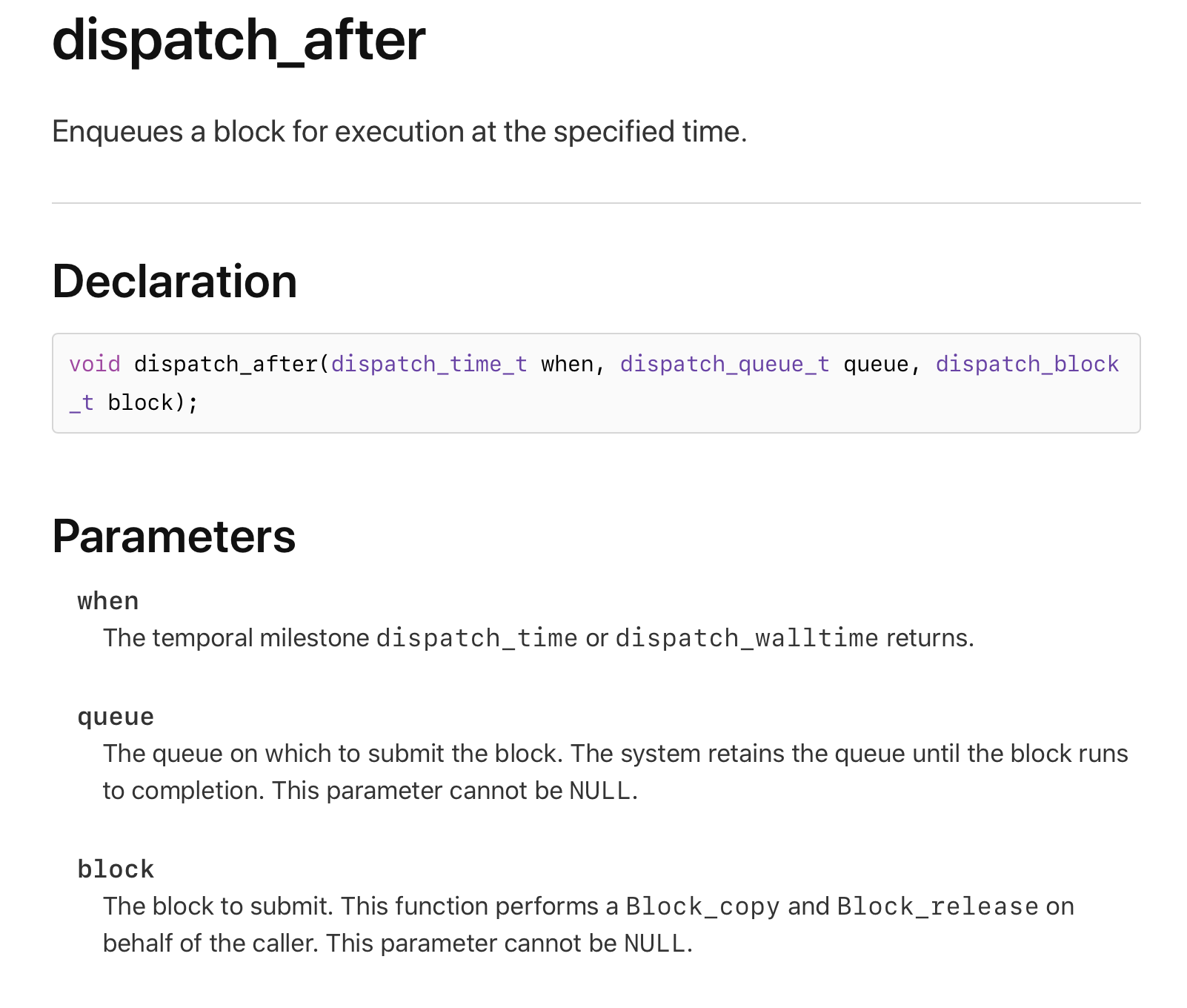苹果对编译器在不断优化,GCD方法中的block基本都不需要使用weakself,并不会造成循环引用。
dispatch_after官方文档中对block部分的说明:

一:使用self
从ViewControllerA push 到 ViewControllerB。ViewControllerB中代码:
#import "ViewControllerB.h" @interface ViewControllerB () @end @implementation ViewControllerB - (void)viewDidLoad { [super viewDidLoad]; // Do any additional setup after loading the view. self.view.backgroundColor = [UIColor blueColor]; } - (void)touchesBegan:(NSSet<UITouch *> *)touches withEvent:(UIEvent *)event { dispatch_after(dispatch_time(DISPATCH_TIME_NOW, (int64_t)(10 * NSEC_PER_SEC)), dispatch_get_main_queue(), ^{ [self log]; }); [self.navigationController popViewControllerAnimated:YES]; } - (void)log { NSLog(@"Finish"); } - (void)dealloc { NSLog(@"dealloc"); }
输出结果

pop事件后,ViewControllerB关闭,但并没有立刻调用dealloc方法。而是等待倒计时结束后,log方法执行完成,然后再调用dealloc方法。
整个过程不会发生循环引用,在dispatch_after时间结束之前,block强持有self,时间结束后,block被释放,随后ViewControllerB被释放。
二:使用weakself
将代码修改为
- (void)touchesBegan:(NSSet<UITouch *> *)touches withEvent:(UIEvent *)event { NSLog(@"pop action"); __weak ViewControllerB *weakself = self; dispatch_after(dispatch_time(DISPATCH_TIME_NOW, (int64_t)(10 * NSEC_PER_SEC)), dispatch_get_main_queue(), ^{ [weakself log]; }); [self.navigationController popViewControllerAnimated:YES]; }
输出结果

在pop之后,立即调用了dealloc方法,ViewControllerB被释放。不会调用log方法。
三:使用weak-strong dance
将代码修改为
- (void)touchesBegan:(NSSet<UITouch *> *)touches withEvent:(UIEvent *)event { NSLog(@"pop action"); __weak ViewControllerB *weakself = self; dispatch_after(dispatch_time(DISPATCH_TIME_NOW, (int64_t)(10 * NSEC_PER_SEC)), dispatch_get_main_queue(), ^{ __strong ViewControllerB *strongself = weakself; [strongself log]; }); [self.navigationController popViewControllerAnimated:YES]; }
结果与使用weakself相同。
四:结论
1:上述代码中,如果去除[self.navigationController popViewControllerAnimated:YES]操作,三种方法都能够正常完成任务。
2:当block时间内,如果返回上一页面或其他类似操作,导致当前ViewController消失时。
使用self,ViewController会被block强引用,block时间截止完成回调后,释放block,进而释放ViewController。
使用weakself时,不存在强引用,ViewController会被直接销毁。
3:weak-strong dance,在dispatch_after中并没有实际意义。